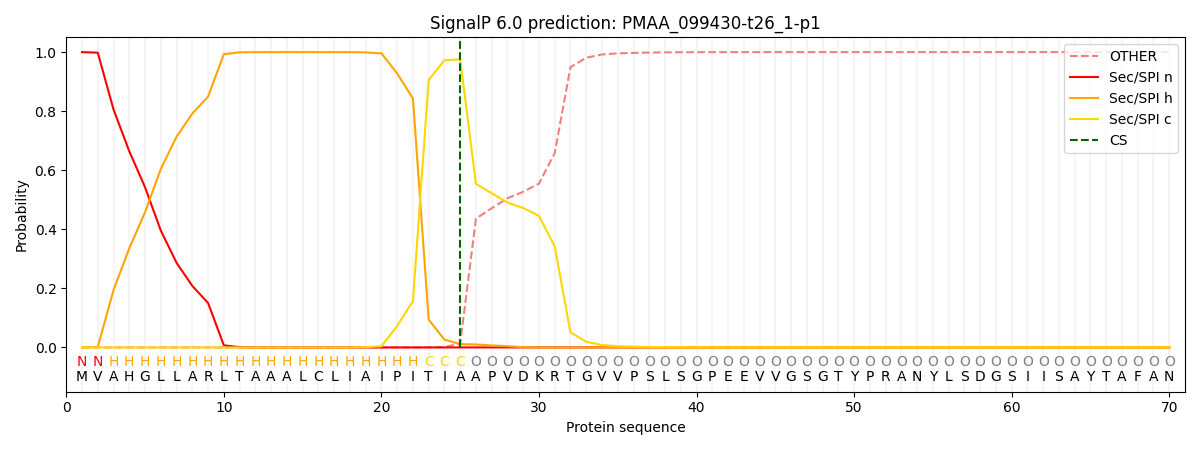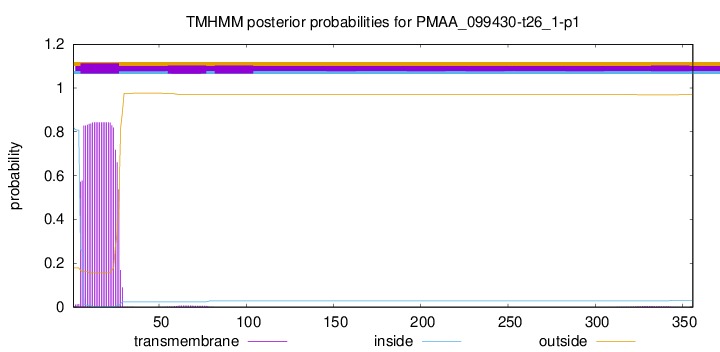You are browsing environment: FUNGIDB
CAZyme Information: PMAA_099430-t26_1-p1
You are here: Home > Sequence: PMAA_099430-t26_1-p1
Basic Information |
Genomic context |
Full Sequence |
Enzyme annotations |
CAZy signature domains |
CDD domains |
CAZyme hits |
PDB hits |
Swiss-Prot hits |
SignalP and Lipop annotations |
TMHMM annotations
Basic Information help
| Species | Talaromyces marneffei | |||||||||||
|---|---|---|---|---|---|---|---|---|---|---|---|---|
| Lineage | Ascomycota; Eurotiomycetes; ; Trichocomaceae; Talaromyces; Talaromyces marneffei | |||||||||||
| CAZyme ID | PMAA_099430-t26_1-p1 | |||||||||||
| CAZy Family | GT31 | |||||||||||
| CAZyme Description | conserved hypothetical protein | |||||||||||
| CAZyme Property |
|
|||||||||||
| Genome Property |
|
|||||||||||
| Gene Location | Start: 2492863; End:2493933 Strand: + | |||||||||||
Full Sequence Download help
| MVAHGLLARL TAAALCLIAI PITIAAPVDK RTGVVPSLSG PEEVVGSGTY PRANYLSDGS | 60 |
| IISAYTAFAN GDSIVTIARS TDKGVSWNEI GTVARGPTAI TDIDNPYIYQ LPSGRVLVAF | 120 |
| RNHDRSNGVY TFFRITICYS DDNGANWAYL STPASDPGPT HGNWEPFLRM AEDGTTLQLY | 180 |
| YSRENSGADQ DSLMRTSTNG GITWTSATVI SGADSNNARD GMLGVTRVSG SNLIAVFESE | 240 |
| TNGGKFSIHS ITSSDDGATW GNRQTVYAPA GSNAQAPQVI KVGGTLVASF QTDEDGGSGE | 300 |
| AIKILTSGNG GVTWGNKLTT FPAASNWAGL LALNDGVSFL SLADHAGAKS QKITLY | 356 |
CAZyme Signature Domains help
| Family | Start | End | Evalue | family coverage |
|---|---|---|---|---|
| GH93 | 47 | 300 | 3.9e-62 | 0.8990228013029316 |
CDD Domains download full data without filtering help
| Cdd ID | Domain | E-Value | qStart | qEnd | sStart | sEnd | Domain Description |
|---|---|---|---|---|---|---|---|
| 271234 | Sialidase_non-viral | 6.13e-12 | 39 | 303 | 60 | 334 | Non-viral sialidases. Sialidases or neuraminidases function to bind and hydrolyze terminal sialic acid residues from various glycoconjugates, they play vital roles in pathogenesis, bacterial nutrition and cellular interactions. They have a six-bladed, beta-propeller fold with the non-viral sialidases containing 2-5 Asp-box motifs (most commonly Ser/Thr-X-Asp-[X]-Gly-X-Thr- Trp/Phe). This CD includes eubacterial and eukaryotic sialidases. |
| 271234 | Sialidase_non-viral | 6.96e-11 | 55 | 276 | 21 | 253 | Non-viral sialidases. Sialidases or neuraminidases function to bind and hydrolyze terminal sialic acid residues from various glycoconjugates, they play vital roles in pathogenesis, bacterial nutrition and cellular interactions. They have a six-bladed, beta-propeller fold with the non-viral sialidases containing 2-5 Asp-box motifs (most commonly Ser/Thr-X-Asp-[X]-Gly-X-Thr- Trp/Phe). This CD includes eubacterial and eukaryotic sialidases. |
| 271234 | Sialidase_non-viral | 6.40e-08 | 171 | 314 | 22 | 186 | Non-viral sialidases. Sialidases or neuraminidases function to bind and hydrolyze terminal sialic acid residues from various glycoconjugates, they play vital roles in pathogenesis, bacterial nutrition and cellular interactions. They have a six-bladed, beta-propeller fold with the non-viral sialidases containing 2-5 Asp-box motifs (most commonly Ser/Thr-X-Asp-[X]-Gly-X-Thr- Trp/Phe). This CD includes eubacterial and eukaryotic sialidases. |
| 350091 | GH43_62_32_68_117_130 | 1.06e-04 | 138 | 332 | 29 | 234 | Glycosyl hydrolase families: GH43, GH62, GH32, GH68, GH117, CH130. Members of the glycosyl hydrolase families 32, 43, 62, 68, 117 and 130 (GH32, GH43, GH62, GH68, GH117, GH130) all possess 5-bladed beta-propeller domains and comprise clans F and J, as classified by the carbohydrate-active enzymes database (CAZY). Clan F consists of families GH43 and GH62. GH43 includes beta-xylosidases (EC 3.2.1.37), beta-xylanases (EC 3.2.1.8), alpha-L-arabinases (EC 3.2.1.99), and alpha-L-arabinofuranosidases (EC 3.2.1.55), using aryl-glycosides as substrates, while family GH62 contains alpha-L-arabinofuranosidases (EC 3.2.1.55) that specifically cleave either alpha-1,2 or alpha-1,3-L-arabinofuranose sidechains from xylans. These are inverting enzymes (i.e. they invert the stereochemistry of the anomeric carbon atom of the substrate) that have an aspartate as the catalytic general base, a glutamate as the catalytic general acid and another aspartate that is responsible for pKa modulation and orienting the catalytic acid. Clan J consists of families GH32 and GH68. GH32 comprises sucrose-6-phosphate hydrolases, invertases (EC 3.2.1.26), inulinases (EC 3.2.1.7), levanases (EC 3.2.1.65), eukaryotic fructosyltransferases, and bacterial fructanotransferases while GH68 consists of frucosyltransferases (FTFs) that include levansucrase (EC 2.4.1.10); beta-fructofuranosidase (EC 3.2.1.26); inulosucrase (EC 2.4.1.9), while GH68 consists of frucosyltransferases (FTFs) that include levansucrase (EC 2.4.1.10); beta-fructofuranosidase (EC 3.2.1.26); inulosucrase (EC 2.4.1.9), all of which use sucrose as their preferential donor substrate. Members of this clan are retaining enzymes (i.e. they retain the configuration at anomeric carbon atom of the substrate) that catalyze hydrolysis in two steps involving a covalent glycosyl enzyme intermediate: an aspartate located close to the N-terminus acts as the catalytic nucleophile and a glutamate acts as the general acid/base; a conserved aspartate residue in the Arg-Asp-Pro (RDP) motif stabilizes the transition state. Structures of all families in the two clans manifest a funnel-shaped active site that comprises two subsites with a single route for access by ligands. Also included in this superfamily are GH117 enzymes that have exo-alpha-1,3-(3,6-anhydro)-l-galactosidase activity, removing terminal non-reducing alpha-1,3-linked 3,6-anhydro-l-galactose residues from their neoagarose substrate, and GH130 that are phosphorylases and hydrolases for beta-mannosides, involved in the bacterial utilization of mannans or N-linked glycans. |
| 404074 | BNR_2 | 2.07e-04 | 73 | 287 | 80 | 278 | BNR repeat-like domain. This family of proteins contains BNR-like repeats suggesting these proteins may act as sialidases. |
CAZyme Hits help
| Hit ID | E-Value | Query Start | Query End | Hit Start | Hit End |
|---|---|---|---|---|---|
| QGA18927.1|GH93 | 1.45e-256 | 1 | 356 | 1 | 356 |
| QKX54349.1|GH93 | 2.37e-150 | 1 | 355 | 1 | 362 |
| QKX63957.1|GH93 | 3.39e-148 | 29 | 355 | 26 | 364 |
| UKZ88867.1|GH93 | 4.25e-90 | 29 | 355 | 25 | 361 |
| UKZ70572.1|GH93 | 2.56e-89 | 20 | 355 | 12 | 363 |
SignalP and Lipop Annotations help
This protein is predicted as SP

| Other | SP_Sec_SPI | CS Position |
|---|---|---|
| 0.000278 | 0.999695 | CS pos: 25-26. Pr: 0.9753 |

